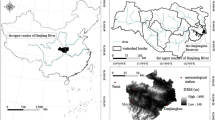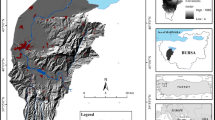Abstract
Due to fragmentized terrain and physiognomy of typical loess landform, long-term anthropogenic influences, and inherent vulnerability, soil erosion is a serious problem in the Loess Plateau of China. There is a critical need to assess soil erosion and spatial distribution for achieving sustainable land use and comprehensive soil conservation management. Taking the Yangou watershed as a case and using the Landsat Thematic Mapper image (land use map), Digital Elevation Model (DEM), soil maps, and precipitation data, this study integrated the revised universal soil loss equation (RUSLE) with GIS technology to estimate soil loss and its spatial distribution. The benefits of soil conservation of land use types were analyzed and the measures for future soil conservation planning were discussed. The results show that silt-covered land and terrace have high benefits of soil conservation, indicating that building check dam, producing silt-covered land for farming, and converting sloped farmland to terrace are effective ways to control soil erosion in the Yangou watershed. Furthermore, increasing vegetation coverage on lower coverage grassland, especially on the slopes with gradients >25°, and eliminating human disturbance in barren areas are feasible and effective measures for soil conservation planning. This study reveals that the integrated RUSLE-GIS model can evaluate and map soil erosion quantitatively and spatially at watershed scale in the Loess Plateau of China. The findings suggest strategies for coping with future soil conservation planning and provide valuable references for future assessments both in the Loess Plateau of China and elsewhere.







Similar content being viewed by others
References
Aksoy H, Kavvas ML (2005) A review of hillslope and watershed scale erosion and sediment transport models. Catena 64:247–271
Angima AD, Stott DE, O’Nell MK, Ong CK, Weesies GA (2003) Soil erosion prediction using RUSLE for central Kenyan Highland conditions. Agric Ecosyst Environ 97:295–308
Cai CF, Ding SW, Shi ZH, Huang L, Zhang GY (2000) Study of applying USLE and geographical information system IDRISI to predict soil erosion in small watershed. J Soil Water Conserv 14:19–24 (in Chinese)
Dang X, Liu G (2012) Emergy measures of carrying capacity and sustainability of a target region for an ecological restoration programme: a case study in Loess Hilly Region, China. J Environ Manage 102:55–64
Febles JM, Vega MB, Tolon A, Lastra X (2012) Assessment of soil erosion in Karst regions of havana, Cuba. Land Degrad Dev 23:465–474
Feng X, Wang Y, Chen L, Fu BJ, Bai G (2010) Modeling soil erosion and its response to land-use change in hilly catchments of the Chinese Loess Plateau. Geomorphology 118:239–248
Fernandez C, Wu JQ, McCool DK, Stockle CO (2003) Estimating water erosion and sediment yield with GIS, RUSLE and SEDD. J Soil Water Conserv 58:128–136
Fu BJ, Meng QH, Qiu Y, Zhao WW, Zhang QJ, Davidson DA (2004) Effects of land use on soil erosion and nitrogen loss in the hilly area of the Loess Plateau, China. Land Degrad Dev 15:87–96
Fu BJ, Zhao WW, Chen LD, Zhang QJ, Lu YH, Gulinck H, Poesen J (2005) Assessment of soil erosion at large watershed scale using RUSLE and GIS: a case study in the Loess Plateau of China. Land Degrad Dev 16:73–85
Hessel R, Van Asch T (2003) Modelling gully erosion for a small catchment on the Chinese Loess Plateau. Catena 54:131–146
Hickey R (2000) Slope angle and slope length solutions for GIS. Cartography 29:1–8
Ju T, Liu P, Zheng S (2000) Primary report on monitoring sediment in Yan’er gully valley. Res Soil Water Conserv 7:176–178 (in Chinese)
Kang SZ, Zhang L, Song XY, Zhang SH, Liu XZ, Liang YL, Zheng SQ (2001) Runoff and sediment loss response to rainfall and land use in two agricultural catchments on the Loess Plateau of China. Hydrol Process 15:977–988
Lee GS, Lee HS (2006) Scaling effect for estimating soil loss in the RUSLE model using remotely sensed geospatial data in Korea. Hydrol Earth Syst Sci 3:135–157
Li SC, Luo LF, Zhang KL, Qiu Y, Liu Y (2004) Simulation on effects of land use change on soil erosion on Loess Plateau. J Soil Water Conserv 18:74–81 (in Chinese)
Liu BY, Xie Y, Zhang KL (2001) Soil loss prediction model. China Science and Technology Press, Beijing (in Chinese)
Lu D, Li G, Valladares G, Batistella M (2004) Mapping soil erosion risk in Rondonia, Brazilian Amazonia: using RUSLE, remote sensing and GIS. Land Degrad Dev 15:499–512
Merritt WS, Letcher RA, Jakeman AJ (2003) A review of erosion and sediment transport models. Environ Model Softw 18:761–799
Oldeman LR, Van Engelen VWP, Pulles JHM (1990) The extent of human induced soil degradation. In: Oldeman LR, Hakkeling RTA, Sombroek WG (eds) Annex 5 of World man of the status of Human-induced soil degradation: an explanatory note, 2nd edn. International Soil Reference and Information Center, Wageningen, Netherlands
Pan J, Wen Y (2014) Estimation of soil erosion using RUSLE in Caijiamiao watershed, China. Nat Hazards 71:2187–2205
Parysow P, Wang GX, Gertner G, Anderson AB (2003) Spatial uncertainty analysis for mapping soil erodibility based on joint sequential simulation. Catena 53:65–78
Renard KG, Foster GR, Weesies GA, McCool DK, Yoder DC (1997) Predicting soil erosion by water: a guide to conservation planning with the Revised Universal Soil Loss Equation (RUSLE). United States department of Agriculture. Handbook no. 703. United States Government Printing Office, Washington, DC
Russell SH, William WD (2001) Landscape erosion and evolution modelling. Kluwer Academic/Plenum Publishers, New York, NY
Shi ZH, Cai CF, Ding SW, Wang TW, Chow TL (2004) Soil conservation planning at the small watershed level using RUSLE with GIS: a case study in the Three Gorge Area of China. Catena 55:33–48
Stanley SW, Pierre C (2000) US soil erosion rates—myth and reality. Science 289:248–250
Tang Q, Bennett SJ, Xu Y, Li Y (2013) Agricultural practices and sustainable livelihoods: rural transformation within the Loess Plateau, China. Appl Geo 41:15–23
Terranova O, Antronico L, Coscarelli R, Iaquinta P (2009) Soil erosion risk scenarios in the Mediterranean environment using RUSLE and GIS: an application model for Calabria (southern Italy). Geomorphology 112:228–245
Van Romortel R, Hamilton M, Hickey R (2001) Estimating the LS factor for RUSLE through iterative slope length processing of digital elevation data within ArcInfo grid. Cartography 30:27–35
Wang BW, Yang QK, Liu ZH, Meng QX (2007) Change of soil erosion intensity due to conservation of farmland to forest and grassland in Yanhe River Basin. Sci Soil Water Conserv 5:27–33 (in Chinese)
Wischmeier WH (1971) A soil erodibility nomograph for farmland and construction sites. J Soil Water Conserv 26:189–193
Wischmeier WH, Smith DD (1978) Predicting rainfall erosion losses: a guide to conservation planning. United States department of Agriculture—handbook no. 537. United States Government Printing Office, Washington, DC
Xu Y, Sidle RC (2001) Research on land use change and its regulation of Yangou watershed in loess hilly-gully region. Acta Geographica Sinica 56:681–710 (in Chinese)
Xu Y, Tian J, Shen H (2002) Eco-environmental rehabilitation and spatial differentiation based on enlarging terrace and defarming in the loess hilly-gully region. J Nat Resources 17:430–437 (in Chinese)
Xu Y, Tang Q, Zhang T, Yang Q (2009a) Influence of ecological defarming scenarios on agriculture in Ansai county, Loess Plateau, China. Mt Res Dev 29:36–45
Xu Y, Yang B, Liu GB, Liu PL (2009b) Topographic differentiation simulation of crop yield and soil and water loss on the Loess Plateau. J Geog Sci 19:331–339
Xu YQ, Peng J, Shao XM (2009c) Assessment of soil erosion using RUSLE and GIS: a case study of the Maotiao River watershed, Guizhou Province, China. Environ Geol 56:1643–1652
Yang QK, Li R, Zhang XP, Hu LJ (2002) Regional evaluation of soil erosion by water: a case study in the Loess Plateau of China. 12th ISCO Conference, Beijing
Zhang Y, Yuan JP, Liu BY (2002) Advance in researches on vegetation cover and management factor in the soil erosion prediction model. Chin J Appl Ecol 13:1033–1036 (in Chinese)
Zhang JC, Zhuang JY, Su JS, Nakamura H, Ishikawa H, Cheng P, Fu J (2008) Development of GIS-based FUSLE model in a Chinese fir forest sub-catchment with a focus on the litter in the Dabie Mountains, China. For Ecol Manage 255:2782–2789
Zhao WW, Fu BJ, Chen LD, Zhang QJ (2004) Land Change and Eco-environmental Construction, The Physical Geography Committee of GSC., Estimation of rainfall erosivity using rainfall amount: a case study in hilly and gully area of Loess Plateau in northern ShaanxiCommercial Press Publisher, Beijing (in Chinese)
Zheng FL (2006) Effect of vegetation changes on soil erosion on the Loess Plateau. Pedosphere 16:420–427
Zhou ZC, Shangguan ZP, Zhao D (2006) Modeling vegetation coverage and soil erosion in the Loess Plateau Area of China. Ecol Model 198:263–268
Acknowledgments
This study was supported by the National Natural Science Foundation of China (Grant No. 41301121), the Key Project for the Strategic Science Plan in IGSNRR, CAS (Grant No. 2012ZD006), and the National Natural Science Foundation of China (Grant No. 41171449). The insightful and constructive comments of three anonymous reviewers are greatly appreciated.
Author information
Authors and Affiliations
Corresponding author
Rights and permissions
About this article
Cite this article
Tang, Q., Xu, Y., Bennett, S.J. et al. Assessment of soil erosion using RUSLE and GIS: a case study of the Yangou watershed in the Loess Plateau, China. Environ Earth Sci 73, 1715–1724 (2015). https://doi.org/10.1007/s12665-014-3523-z
Received:
Accepted:
Published:
Issue Date:
DOI: https://doi.org/10.1007/s12665-014-3523-z




